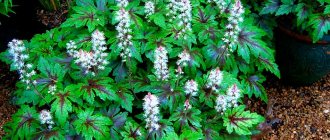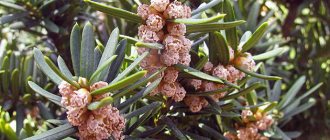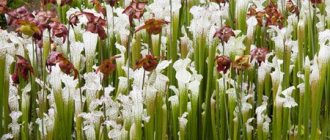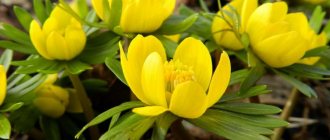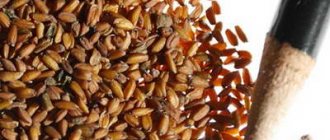Author: Natalya Category: Garden plants Published: August 09, 2018Republished: February 10, 2019Last edits: January 13, 2021
- Growing conditions
- Incarnate cottonweed (Asclepias incarnata)
Fleeceweed, or asclepias (lat. Asclepias) is a genus of the Kutrovye family, which includes more than 200 species of shrubs, subshrubs and herbaceous perennials from South and North America. Members of the genus include both deciduous and evergreen species, and some of them have gained popularity as cultivated ornamental plants. The genus received its Latin name in honor of Aesculapius (Asclepius) for the medicinal properties of some of its representatives. The famous missionary, linguist, historian and explorer of Mexico, Bernardino de Sahagún, in his work “General History of the Affairs of New Spain,” cited evidence from the Aztecs that they used cotton wool to treat tumors arising from bone displacement. Cottonweed came to Europe in the 18th century as an industrial crop and spread very quickly: rope and stuffing for furniture and soft toys were made from the fibers of its stems. Later, film and all kinds of life-saving equipment were made from it. With the advent of rubber, interest in cotton wool as a raw material was lost, but this plant can still be found in gardens and parks.
Description of the plant Vatochnik
The cottonweed (Asclepias) is a genus from the Kutrov family (Apocynaceae). It contains shrubs, subshrubs, perennial herbs and evergreens. These are plants with opposite or alternate leaves; they can be elliptical, ovate, or lanceolate. The inflorescences are umbrella-shaped, the colors of the flowers are red, white, pink, orange and have a rather pleasant aroma. The cottonweed has strong roots that lie deep in the soil. The plant is a good honey plant.
The seeds of the cottonweed have white fibers, hence its name. In culture, 1 species is used as an annual plant, and 3 species as a perennial plant. There are about 80 species in the genus. Cottonweed juice is poisonous, so you should be careful.
Care
After planting, the plant needs to be watered regularly until it can extract water from the deep layers of the soil on its own. After rooting, watering should only be done during dry periods. The only exception is the meat-red species, which loves moist soil.
Wilted flowers should be trimmed immediately to avoid self-sowing. Because otherwise it will be difficult to eradicate cottonweed that has grown in flower beds with other garden plants.
Asclepias speciosa
Asklepias can tolerate frosts up to 13 degrees. If you grow it at home, you need to spray it regularly in winter. You can use fallen leaves and cut stems as cover. For the winter, 10 cm of the stem is left, the rest is removed.
In spring, the shelter is removed. The first shoots appear in April. It is during this period that the plant needs to be fertilized. Complex fertilizers are suitable for this purpose. If the plant was planted on fertile soil, then it can not be fed for 3-5 years. It is advisable to carry out timely weeding and mulching of the soil.
A change of place of residence of the fleece owner should be carried out every 10 years .
The cottonweed sheds its buds - what to do?
Sometimes it happens that the cottontail plant drops its buds. To avoid such a situation, do not rearrange it during the period of budding and flowering. This plant loves direct sunlight and is drought tolerant. But the reason for the loss of buds can also be drying out of the soil. Therefore, on the hottest days you need to monitor soil moisture.
Caring for Vatochnik
Open places are suitable for him; he loves the sun, but some varieties of cotton grass also react calmly to light shade. For example, meat-red and Syrian species. However, in the shade the latter may bloom later, but it also blooms longer. The tuberose variety is the most sensitive to light; in the shade it develops and blooms poorly.
A rapidly growing bush can be made more compact by limiting it to a border. This is especially true for the Syrian species. Alternatively, it is possible to dig a container into the ground with holes for drainage and plant the plant in it. Or place the fleece in a tank without a bottom. Periodically, the cottonweed needs weeding and loosening, especially for young specimens.
Watering
Here it is necessary to maintain a balance without allowing drought or too much watering. Some of the most moisture-loving are Syrian and tuberose cottonweed.
Winter hardiness
The most winter-hardy varieties of cottonweed are incarnate and Syrian, but they also need shelter. For the winter, the plant is insulated with dry leaves, spruce branches, and agrofibre. The soil is mulched with peat and compost.
In the spring, the cover is removed, and new growth appears on the fleece. The tuberose species does not tolerate low temperatures and is grown as an annual. The Kurassawa variety is also very thermophilic. It is grown indoors or as an annual in open ground.
Top dressing
It is good to apply fertilizers before flowering, when the buds are forming. Potassium sulfate and urea are suitable here. And when the milkweed has flowered, it is useful to feed it with nitrophoska. The first spring fertilizing with mineral compounds is carried out after removing the winter shelter.
Bloom
The cottonweed blooms in autumn or spring, depending on the species. Faded buds are cut off.
Trimming
The plant does not respond well to the procedure, but sanitary pruning is necessary for perennial species. For the winter, you can cut off the above-ground part of the cotton wool. But many recommend preserving the foliage and stem and cutting off old shoots in the spring.
Transfer
The bush grows quietly in one place for up to 15 years. It is replanted as needed. The milkweed tolerates the procedure well. It is better to do it after watering so that there is soil on the roots. It is good to combine it with dividing the bush. Watering should be increased for some time after transplantation.
Features of the plant
Regardless of the type and variety, Vatochnik has bright inflorescences. The average length is 100 cm, the stem is thick, on which the leaves are located. They can be oblong or ovoid in shape.
Flowering begins in mid-July (depending on the species) and ends only in autumn. After this, seed formation begins.
Despite the attractive appearance and fragrant aroma, the stems of the plant contain poisonous juice. It is necessary to avoid getting it on the mucous membranes, as well as on the skin. If it comes into contact with the skin, this liquid may cause red spots and itching. The effect will be enhanced if the area where the juice hits is exposed to sunlight. If the juice does get on your skin, it is recommended to immediately wash it off under running water.
There are cases when Vatochnik juice is used in folk medicine. So, the liquid can be used to remove warts and papillomas, but only after consulting a doctor.
Growing cottonweed seedlings
Seeds are sown in March-early April in seedling containers. A loose substrate is suitable for them. The optimal temperature for germination is about 23°C. Shoots can be expected after 10 days. When they appear, the seedlings must be transferred to a cool place and exposed to light. You can sow in February using additional lighting. This is especially true for the tuberose species, since it blooms in the same year. When the seedlings grow up, you can pinch off the tops. It is moved into open ground in early June, planted immediately in a permanent place. This type of cotton grass will bloom in 3 years. The exception is the tuberose variety. You can expect it to bloom the same year.
Landing rules
Asklepias is an unpretentious ornamental plant, but there are still some peculiarities in its cultivation.
- Grows on any soil, but preference is given to loamy and slightly acidic soil. It is recommended to choose an open, sunny, well-ventilated place for planting. Damp and swampy areas with groundwater located close to the top layer of soil are undesirable.
- It is better not to plant anything within a radius of two meters, because the milkweed grows greatly, especially the Syrian one. The latter is sometimes planted in a pot in open ground to limit the growth of root shoots. For him, a drainage layer in the pot is important and mandatory.
- All cereal crops will be bad neighbors for the handsome cottonweed. But it gets along very well with decorative ones. Bluebells, echinacea, meadowsweet and asclepias will complement each other perfectly.
Before planting the plants, it is necessary to dig up the soil well, free it from weeds and loosen it. Some gardeners add compost to the soil to fertilize. The most important thing is to take into account the strong growth of the flower and choose a place that is spacious enough so that it does not suppress other flowers and feels comfortable.
Reproduction of Vatochnik
Seeds
Seeds are usually sown in open ground at the end of May. Before this, they need stratification in cold sand for about a month. Then they are covered with film until shoots appear. Pre-winter sowing is also possible in regions with mild climates.
By division
It is better to divide in spring or after flowering. The root is divided into parts with buds. The delenka is planted in a separate hole, watered and sprinkled with earth. The cottontail plant takes root easily. It can bloom within a year. Delenki need increased watering, it is reduced when the cotton wool has formed a powerful root system.
Cuttings
The procedure is carried out at the beginning of summer. The shoots are cut into cuttings. If the sap does not have time to dry, the cutting will take root faster. Wet sand is suitable for rooting. They usually take root in 2-3 weeks.
Planting cottonweed in open ground
What time to plant
In mid-latitudes, milkweed is grown through seedlings, and even without seedlings. The seeds of this crop remain viable for 3 years, but they do not have time to ripen every year, but only when the summer is very hot. But seed material can always be bought at a specialized store.
Sowing seeds for seedlings is carried out in the last days of March or the first days of April. To do this, use boxes with drainage holes; they should be filled with loamy soil. The seeds are buried 1–1.5 cm into the substrate, then they are watered using a sprayer. The containers must be covered with glass or film, and then they are put away in a warm place. The crops are ventilated every day, and at the same time the condensation that has accumulated on the shelter is removed. Watering is carried out using a sprayer once every two or three days. Friendly shoots should appear after 1.5–2 weeks, after which they are transferred to a cooler place (no more than 18 degrees). The cover is removed from the container after the plant has grown stronger. Usually seedlings grow very well and do not cause problems for the gardener.
Seedlings are picked when they begin to form two pairs of true leaf blades. For picking, individual cups are used, into which drainage is poured, and the layer thickness should be about 20–30 mm. And they are filled with the same soil mixture that is used for sowing seeds. Transplanted plants must be protected from direct sunlight during the first two days. After the seedlings have taken root well, you need to pinch them.
Before planting cotton wool in open ground, it should be hardened for 15 days. Seedlings are planted in the first days of June, following a 50x50 cm pattern. Bushes grown from seeds will bloom for the first time in the 3rd or 4th year of growth.
Sowing seeds can be done directly into open soil. This is done in early spring, immediately after the snow cover melts. The site should be sunny with cultivated soil. Fleeceweed grows best on slightly acidic, nutritious loam.
Landing rules
First, you need to dig up the soil to the depth of a spade bayonet, and you need to select all the roots of the weed. Then the surface of the area is leveled and grooves are made in it. The seed is buried 30 mm into the soil, then the furrows are sealed and the crops are well watered. If the seeds were sown in dry soil, it is recommended to cover the crops with film, thanks to which the seedlings will appear much faster.
Certain types of such plants require a restriction, which is set during planting, since young shoots can germinate almost 100 cm from the parent bush. To prevent such a flower from growing too much, you can use limiters or plant the bushes in containers dug into the ground that have holes for drainage. If you take good care of the cotton grass, then it can be grown in the same place for about 15 years.
Varieties and types of Vatochnik
Syrian cottonweed (A. syriaca)
Perennial up to 150 cm tall. The flowers are large, pink or white. Flowering time is July;
Incarnate cottonweed (meat-red) (A. incarnata)
Perennial up to 100 cm tall with purple or red flowers. Flowering time is July-August. There is a white-flowered variety;
Tuberwort (A. tuberosa)
The plant is low, about 60 cm, with orange flowers. It blooms from July and almost all autumn. There are options with yellow and red flower colors;
Video review
About an unpretentious and little-known plant for the garden, cottonweed, in the “Garden World” program.
Very rarely in amateur gardens you can find this interesting plant, which has several names. It doesn't really stand out with its flowers or leaves. Most likely, it is attracted by the incomparable aroma spreading around the delicate inflorescences. How to grow a flower in a personal plot, starting from planting? How to properly care for a plant in open ground and which varieties are best suited? You can find answers to these questions, as well as get practical advice on growing cottonweed in your own garden, by studying the article.
Description of the cottonweed, its varieties and varieties
In its homeland, South America, the plant grew so much that it was classified as a weed to be destroyed. At the end of the 17th century, cotton wool came to Europe, where it was used to make ropes, as furniture stuffing, etc.
Nowadays it is not used for production purposes, but is grown as an ornamental plant in gardens. The herbaceous shrub is called differently: vatochnik, lastoven, asklepias. About 80 species of it can be found in nature. Its planting is not yet popular among residential buildings, but the cotton grass is gradually gaining its place in the garden.
The milkweed has a wonderful aroma
The fleece looks like this:
- A powerful plant whose stems can exceed the average height of a person. They are hollow inside. Milky juice appears at the fracture.
- The leaves are large, elongated, lanceolate in shape. The bottom is covered with light pile, reminiscent of felt. Along the stem they are located opposite to each other.
- The umbrella inflorescences, consisting of small flowers, have a very pleasant aroma.
- The seeds are covered with cotton wool, clearly visible in the photo. If grown in open ground in the middle zone, they do not ripen.
Attention! All parts of the plant are poisonous. Therefore, when working with cotton wool, precautions should be taken.
Only some species are used in culture.
- Syrian cottonweed - covered with pink inflorescences in July.
They do not fade for about a month. The plant does not need special care. It is distinguished by large ovate leaves. Its root cuttings can germinate at a distance of more than a meter from the bush, due to which the plant reproduces very quickly. Syrian cottontail - Meat-red milkweed - the flowers on the plant are purple.
Two varieties are also popular: Ice Ballet with white flowers and Sinderella with pink flowers. The aroma is very delicate. Reminds me of the smell of chocolate. Meat-red milkweed - Tuberous or tuberose cottonweed is short compared to its relatives (up to 60 cm).
Its cultivation is possible not only in open ground, where the plant freezes slightly, but also indoors. Lush orange inflorescences open in summer and fade in late autumn. Tuberous or tuberose cottonweed - Kurassawa cottonweed is a species characterized by a very long flowering period.
You can capture its red-orange inflorescences in a photo both in spring and autumn. In open ground, this asklepias is grown as an annual. It is also possible to plant it in a pot as an indoor crop. Kurassawa cottonweed
Planting rules
The place where the planting will take place must be sunny. Only varieties of the meat-red variety thrive in shade.
Advice. To prevent the strong growth of cottonweed in the area, it is better to dig a container with holes for drainage into the open ground and plant the plant there. This technique will greatly simplify bush care.
The composition of the soil is not particularly important. The cotton grass is planted in a permanent place in the spring. In swampy areas, even moisture-loving varieties of the meat-red variety grow very poorly. It is better to include uniform watering in plant care. If the soil is fertile, then fertilizing during planting is not necessary.
Asclepias care and feeding
Caring for cotton wool is not burdensome. In the summer, the main thing is to carry out timely watering. Although there are drought-resistant varieties, for example, Syrian varieties, the soil should be well moistened on hot days.
In spring, mandatory work includes removing the remains of dried shoots and, if necessary, propagating the flower. In the fall, watering is stopped, the plant is cut off at the root and well covered with leaves for the winter.
The cotton wool plant is unpretentious in care
It is not worth pampering the cotton grass with fertilizers. It is enough to feed the plant twice per season:
- before flowering with urea and potassium sulfate;
- after flowering nitrophoska.
In early spring, to improve growth, you can add organic matter, such as rotted manure or compost, to the root zone.
How to propagate a plant and fight pests
You can propagate cottonweed in three ways:
- using seeds;
- cuttings;
- root suckers.
Among the disadvantages of the first method, we can note the poor germination of seeds and the fact that plants bloom only in the 3rd year. As an exception - the tuberose look. If you start growing its seedlings in February and extend the daylight hours by lighting, then this cottonweed can bloom this year.
The optimal way to propagate cottonweed is by planting root suckers.
Advice. In order for Asclepias to take root well, after replanting it is better to cut the trunk at a height of 10 cm.
Propagation by cuttings is also often practiced by amateurs. For this method, green pieces of shoots are harvested at the beginning of summer. Root them in the sand for several weeks. Plants bloom within a year.
The milky sap of the plant contains substances that provide the plant with protection from pests and pathogens, so the milkweed does not suffer from known diseases. Among the pests, Asclepias can be damaged by spider mites.
Keep in mind that cotton grass can grow strongly on the site
What plants does cottonweed go with?
When planning the landscape on the site, you need to take into account what type of asklepias will be planted. After all, varieties differ in height and volume of the bush. For example, the low tuberose cottonweed, thanks to its orange inflorescences, goes well with lavender, sage, and some cereals.
If we talk about the varieties of Syrian cottonweed, which have fairly tall bushes, then it would be appropriate to plant yarrow, meadowsweet, catnip, and sapling grass next to it.
Waterweed is one of those plants that not everyone decides to have on their property. First of all, gardeners are afraid of its growth. However, with proper care and timely limitation of the spreading of the rhizome, the plant can delight many years with interesting inflorescences and an unusually pleasant aroma.
Unpretentious milkweed: video
This plant is not known to all gardeners and flower growers. It does not bloom as magnificently and luxuriously as, for example,
lilies
or
roses
, the color range is very limited - pink and orange, the bushes are large and branchy - in general,
cottonweed
does not at all pretend to be a garden favorite.
The cotton grass is blooming. And yet this plant is very attractive, original and unusual. Let's take a closer look.
Types, varieties, varieties
In its homeland, South America, the plant grew so much that it was classified as a weed to be destroyed.
At the end of the 17th century, cotton wool came to Europe, where it was used to make ropes, as furniture stuffing, etc. Nowadays it is not used for production purposes, but is grown as an ornamental plant in gardens. The herbaceous shrub is called differently: vatochnik, lastoven, asklepias. About 80 species of it can be found in nature. Its planting is not yet popular among residential buildings, but the cotton grass is gradually gaining its place in the garden.
The milkweed has a wonderful aroma
The fleece looks like this:
- A powerful plant whose stems can exceed the average height of a person. They are hollow inside. Milky juice appears at the fracture.
- The leaves are large, elongated, lanceolate in shape. The bottom is covered with light pile, reminiscent of felt. Along the stem they are located opposite to each other.
- The umbrella inflorescences, consisting of small flowers, have a very pleasant aroma.
- The seeds are covered with cotton wool, clearly visible in the photo. If grown in open ground in the middle zone, they do not ripen.
Only some species are used in culture.
- Syrian cottonweed - covered with pink inflorescences in July. They do not fade for about a month. The plant does not need special care. It is distinguished by large ovate leaves. Its root cuttings can germinate at a distance of more than a meter from the bush, due to which the plant reproduces very quickly.
Syrian cottontail
- Meat-red milkweed - the flowers on the plant are purple. Two varieties are also popular: Ice Ballet with white flowers and Sinderella with pink flowers. The aroma is very delicate. Reminds me of the smell of chocolate.
Meat-red milkweed
- Tuberous or tuberose cottonweed is short compared to its relatives (up to 60 cm). Its cultivation is possible not only in open ground, where the plant freezes slightly, but also indoors. Lush orange inflorescences open in summer and fade in late autumn.
Tuberous or tuberose cottonweed
- Kurassawa cottonweed is a species characterized by a very long flowering period. You can capture its red-orange inflorescences in a photo both in spring and autumn. In open ground, this asklepias is grown as an annual. It is also possible to plant it in a pot as an indoor crop.
Kurassawa cottonweed
Syrian cottonmouth can be found wild in the eastern states of North America. It is a perennial, reaching a height of 1.5 meters, with erect leafy shoots and leaves elongated 10-15 cm in length (5-7 cm wide). The color of the foliage is dark green; in the middle part of summer it often falls off on the lower tiers.
The diameter of the flowers is 1 cm, the color is light pink, they form large umbrella inflorescences. During the flowering period, which begins in July and lasts for about a month, the garden is saturated with the delicious aroma of chocolate cake. The smell of the Syrian cottonweed is somewhat more intense than that of some other species (for example, in comparison with the meat-red cottonweed described below).
The silky seeds of this species can be carried long distances by the wind, but to germinate they need a dry and warm autumn, at least in the middle zone. In addition, it is characterized by frost resistance, implying the complete absence of any shelter for the winter.
The meat-red milkweed (incarnate) also grows in the central regions of North America. Slightly lower in height (1-1.2 meters), it has branched leafy shoots and opposite leaves with a light hairy cover, oblong or broadly lanceolate.
The flower color is either red or pink-purple, they also form umbrellas and emit a pleasant aroma. The flowering period falls in July-August and lasts about the same as that of the Syrian cottonweed. Unlike the latter, the species in question is not so resistant to frost, so using a shelter, for example, from dry foliage, will not hurt it.
In terms of the number of varieties bred, it is significantly ahead of others. Among them, we should highlight the variety Asclepias meat-red ballet on ice with white flowers, cottonweed incarnate cinderella and milkweed meat-red soulmate (soulmate) - with pink flowers. The smell emitted by the flowers of this species is more delicate compared to the Syrian one and is more like chocolate butter.
It is a low (50-70 cm), but very pretty plant. Lush bright red and dark orange inflorescences make the garden composition especially colorful already in mid-summer. This continues almost all autumn, and, like its “brothers”, this cottontail has a subtle, spicy aroma.
The Maharaja variety is characterized by rapid growth, erect shoots, elongated oval foliage and bright orange flowers that attract countless butterflies.
Native to South America, this perennial plant is grown as an annual in cooler climates. The inflorescences of the species are highly decorative; they are used for cutting, taking into account the important feature of all cottonweeds - toxicity.
When plant sap comes in contact with the surface of the skin, it causes serious irritation, and in certain people this effect is also observed from pollen. Red and orange flowers are also very popular with butterflies.
As problem-free winter-hardy perennials, Syrian and meat-red cottonweed are known. For the red milkweed, mulching and a little shelter for the winter is advisable. The Syrian cottontail spends the winter without shelter.
For decorative purposes, one species is used as an annual plant, and three species of this plant are used as a perennial plant.
The homeland of the red meatweed is North America.
Perennial up to 1.2 m tall. Stems are leafy, branched. The leaves of the meat-red cottonweed are opposite, hairy, broadly lanceolate or elongated. The flowers are pink-purple or red with a pleasant scent. It blooms in July for about 30 days. Winter-hardy, for preventive purposes it is better to mulch and cover with spruce branches. The meat-red votochnik has a more delicate aroma than the Syrian one and is reminiscent of chocolate butter.
Low 70 cm plants with orange flowers are a good addition to a composition decorated in green and red tones. Large inflorescences of cottonweed tuberose adorn the shoots from the beginning of summer and throughout almost the entire fall. This cottonweed is quite frost-resistant, but still needs winter shelter and sometimes does not always hibernate even with winter shelter.
Syrian cottonweed
Originally from North America. This cotton wool has nothing to do with Syria.
Perennial. Erect, leafy stems. The foliage is oblong-elliptical. The leaves of the Syrian cottonweed are leathery, slightly reminiscent of the leaves of rhododendrons. The lower leaves often fall off in summer. The flowers are 1 cm in diameter, fragrant, light pink, collected in umbellate inflorescences. Flowering of the Syrian cottonweed occurs in July and lasts about one month.
Syrian milkweed winters without shelter. This milkweed smells stronger than the meaty red milkweed and its aroma is reminiscent of the smell of chocolate cake.
We invite you to familiarize yourself with Autumn pruning of gooseberries: how to get a rich harvest
It has been in culture since 1629. This is the most aggressive plant in terms of growth. It is capable of producing additional shoots at a distance of a meter from its core. Syrian stem is smooth with oblong leaves. The foliage is leathery, dark green. The height of such a fleece is up to 1.5 m.
The flowering period begins in July and lasts about a month. This type is considered the most fragrant. Its aroma is reminiscent of a chocolate bar. The inflorescences are large. The diameter of each flower is 1 cm. In winter, the Syrian cottonweed can do without shelter. You can admire the Syrian honey plant in the photo.
Syrian cottonweed
This perennial cottonweed has been grown since 1635. Its height reaches 1 m. It grows as a bush of regular shape. Its stem is branched, and its leaves are elongated and hairy. It blooms from July to August, for 30-35 days. The diameter of the inflorescences is 6 cm.
Flowers come in white, pink, purple and orange. The incarnate bush is light-loving, but can tolerate slight darkening. In winter, it is advisable to mulch the meat-red plant and provide light cover.
Tuberose cottonweed grows as a bush and grows very quickly. The height, when compared with its relatives, is small - 60 cm.
Tuberose is light- and heat-loving. In winter, shelter often does not save it from freezing. Therefore, before frost, it is advisable to replant them in flowerpots and transfer them to indoor keeping. Indoors and in the greenhouse, the tuberous bush blooms profusely and for a long time. The flowering period for garden maintenance is also long (starting from mid-summer and throughout autumn).
Kurassava Asclepias grows up to 1 m. The longest flowering period is spring - autumn. This species is very thermophilic. Therefore, such a bush is used as an annual planting or grown as a houseplant. The color of the flowers is red-orange.
Asclepias curassavica
Syrian cottonweed can be found wild in the eastern states of North America. It is a perennial, reaching a height of 1.5 meters, with erect leafy shoots and leaves elongated 10-15 cm in length (5-7 cm wide). The color of the foliage is dark green; in the middle part of summer it often falls off on the lower tiers.
Diseases and pests
The poisonous milky sap contained in the above-ground parts of the plant provides it with reliable protection against parasites. The only pest that can cause damage to Asclepias is the spider mite , and only in the absence of appropriate measures.
A good preventative measure in this case is simply spraying with water from a spray bottle; it is even better to use infused onion peels (100 grams of peels per 5 liters of water, leave for 4-5 days, strain and use for spraying).
Among chemical agents, acaricides such as Neoron are highly effective in combating these pests. The drug destroys both the mites themselves and the eggs they lay. Typically 2 treatments with neoron eliminate the entire population.
Vatochnik meat-red or incarnate
Grows in North America
red milkweed (asclepias incarnata).
It grows up to 120 cm, stems branch from the trunk, on which elongated, hairy leaves are densely located. Umbrellas of pink-purple flowers are up to 6 cm in diameter.
Incarnate cottonweed Flowering occurs in July – August and lasts up to 35 days. This species is moisture-loving, and for the winter it should be mulched with leaves or peat. It also has an aroma, but more subtle than in. Syrian. It is not as aggressive and grows in a denser bush.
Has different varieties. Ice Ballet is very beautiful - a tall bush with white inflorescences.
Another type -
tuberose cottonweed (Asclepias tuberosa).
This is a low (50-70 cm), spectacular plant with flowers of a bright orange hue, collected in spherical inflorescences that remain on the plant for a long time. It is quite frost-resistant, but in some cold winters it may not survive even under winter shelter.
Tuberose Butteflies There is a variety mixture called Gay Butteflies with flowers of various colors - orange, yellow and red. In winter, shelter is required.
Evergreen plants of Kurassavsky cottonweed (Asclepias Curassavica) have erect stems about 1 m tall. Dark green leaves are oblong, the flowers are very bright - orange-scarlet with a yellow center, collected in umbrellas, bloom until late autumn. The plant is undemanding to soil, but in extreme heat it needs constant moisture.
After sowing, it blooms within 5 months, so it can be grown as an annual. Propagated by seeds and cuttings.
Kurassawa cottonweed Seeds are pre-soaked in warm water for 20 hours, then sown in containers kept at a temperature of +20...25°C. They germinate slowly - about three months.
Beautiful cottonweed (asclepias speciosa)
- perennial species. Not the largest - reaches 30-70 cm, the stems are covered with pubescence. The leaves are large, with a pointed end, pubescent underneath.
The flowers are greenish-purple, their flat umbrellas are located on the tops of the branches and in the axils of the upper leaves. Blooms in the second half of summer. Moisture-loving and frost-resistant, used for cutting.
Growing cottonweed in the garden does not present any difficulties; almost all ornamental species are very easy to care for. The main thing for him is an open, sunny place and placing plants at a sufficient distance so that they do not crowd each other. It is better to plant V. Syriac in a confining container or dig protection around it so that it does not spread too much.
Almost all species are propagated, usually vegetatively. You can see with your own eyes how to plant Syrian cottonweed and hear a short story about caring for it in the video.
Flowweed plants in the garden should be placed next to the same large perennials as aconites, echinaceas and rudbeckias, veronicastrum; tall ornamental grasses are also good next to them - miscanthus, reed grass, pearl barley.
There are about 80 species of cottonweed growing in North and South America and Africa. Another official name - asklepias - the cotton grass was named in honor of the ancient Greek god of healing Aesculapius (Asclepius) for its healing qualities. When the seeds of this plant ripen, they are covered with a fibrous, cotton-like fluff, giving them a rather distinctive appearance.
Let's get acquainted: the milkweed
It got its name from the cotton-like tufts on the seeds, which were used instead and were also used in making yarn for making various fabrics. They even tried to obtain rubber from the juice of the plant, but soon abandoned this idea.
The milkweed is also used as a medicinal plant. This is probably why its scientific name is medical, derived from the name of the god of healing Asclepius (Aesculapius) - asclepias. It is also called lastoven.
More than 200 species of the genus Asklepias, belonging to the Kutrov family, are known in nature. All of them are inhabitants of both Americas and the African continent. These are mainly deciduous and evergreen plants, shrubs and herbaceous perennials.
Cottonweed inflorescence Asclepias was brought to Europe in the 18th century and at first they tried to use it for technical purposes, then interest in it waned. But the most beautiful species were preserved and migrated to amateur gardens.
Description of the plant
What is a cotton wool plant? This powerful plant with thick, strong stems grows up to a meter or more in height, and has large, usually oval or oblong leaves, arranged in pairs. Thickened rhizomes are located horizontally, often diverging far from the central root. Fragrant flowers of red or brownish color form round complex inflorescences called umbrellas, their smell attracts insects. They bloom in summer or early autumn.
Only a few of the most decorative and winter-hardy species are cultivated. Almost all cottonweeds contain poisonous milky juice in their tissues, which causes irritation when it comes into contact with the skin and mucous membranes. It is especially dangerous on a sunny day.
The homeland of the Syrian cottonweed (Asclepias siriaca) is North America. It got its name through a misunderstanding: the Italian botanist Cornuti confused it with the kendyr plant, which grows in Syria. And when K. Linnaeus was engaged in classification, he left this name for this species and included it in the genus Asklepias.
This species is tall and majestic - its powerful erect stems reach 150 cm in height, densely covered with large (up to 16 cm in length and 5-7 in width) oblong leaves, dark and leathery. The lower leaf blades begin to fall off by mid-summer.
Syrian cottonweed Flowers of this species are quite large (1 cm), light pink. Collected in large umbrella inflorescences, they look extremely impressive and are also very fragrant. Flowering lasts up to 35 days and occurs in the month of July.
The fruits of the cottonweed are large capsules up to 10 cm long. When they open, the wind carries the brown seeds with long white hairs far away. They scatter far from the bush, but in our country cottonweeds almost never reproduce by self-sowing - seed ripening can only happen in a very long, warm autumn.
Cottonweed fruits This species is winter-hardy, very unpretentious and drought-resistant. And although V. Syrian cannot reproduce by seeds in our country, it perfectly fills this gap by aggressively spreading its rhizomes in all directions from the mother plant. Its shoots may appear at a distance of more than a meter from the main bush.
Medicinal properties, use in homeopathy
Asklepias is easy to grow, has beautiful inflorescences and leaves, and can survive in any garden plot. But for all its versatility, the possibilities of using it in landscape design are limited. This is because the cotton grass is quite large and tends to grow throughout the entire territory.
However, its ability to create a tall and lush mass of greenery can be played up. It can be used as a camouflage fence for recreational areas or functional objects (faucets, barrels, telephone boxes, compost pits). The cotton grass makes excellent flower rings against the background of the lawn.
This bush combines with other tall herbaceous plants and cereals. Such “neighbors” can be echinacea, aconite, aster, veronicastrum, high bell and physostegia.
Asclepias with echinaceas along the path
When planning the landscape on the site, you need to take into account what type of asklepias will be planted. After all, varieties differ in height and volume of the bush. For example, the low tuberose cottonweed, thanks to its orange inflorescences, goes well with lavender, sage, and some cereals.
If we talk about the varieties of Syrian cottonweed, which have fairly tall bushes, then it would be appropriate to plant yarrow, meadowsweet, catnip, and sapling grass next to it.
Waterweed is one of those plants that not everyone decides to have on their property. First of all, gardeners are afraid of its growth. However, with proper care and timely limitation of the spreading of the rhizome, the plant can delight many years with interesting inflorescences and an unusually pleasant aroma.
